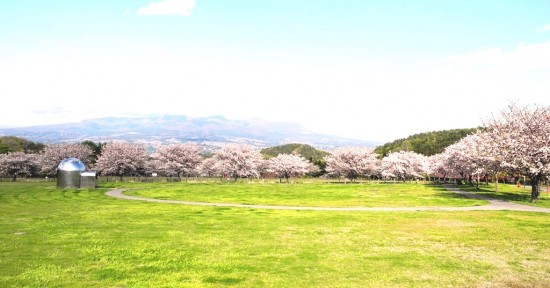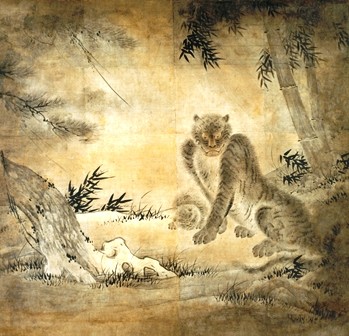Hara Museum ARC is located 500 meters above sea level in the foothills of the Haruna mountain range where Japanese cherry trees of many kinds come into bloom from the middle of April through Golden Week. Nearby attractions include the adjacent Ikaho Green Bokujo and the famed Ikaho hot springs located five minutes away by car.

Hara Museum ARC opened in 1988 as an annex of the Hara Museum of Contemporary Art (Shinagawa-ku, Tokyo / director: Toshio Hara). The sharp forms of its dark-colored buildings designed by Arata Isozaki stand in beautiful contrast with the lushness of the surrounding greenery. The facilities were expanded in 2008 with the addition of a tranquil Japanese-style exhibition space called the Kankai Pavilion and an open-view storage room designed for easy access by researchers and specialists. Contemporary artworks from the Hara Museum Collection and traditional East Asian art from the Hara Rokuro Collection (including the National Treasure Celadon vase with long neck on globular body and Important Cultural Property Female passing through a reed portiere) are on view in its galleries to provide a viewing experience that spans many regions and eras. Guided tours of the exhibits and the open-view storage room are conducted every Sunday at 2:30 (Japanese only / the open-view storage room is restricted to viewers middle school-aged or above; reservation required).

[Scheduled Exhibitions]
Spring Exhibition – Selections from the Hara Museum Collection (tentative title)
March 15 (Saturday) –June 29 (Sunday)
Venue: Contemporary art galleries
This exhibition will feature selected works dating from 1950 onward from the Hara Museum Collection by noted artists from Japan and abroad.
The focus will be large-scale installations by artists on the cutting-edge of the art world today, such as Yayoi Kusama (Mirror Room (Pumpkin) and Tabaimo (midnight sea).
Wall and Panel Paintings by Artists of the Kano School – Selections from the Hara Rokuro Collection
March 15 (Saturday) – May 28 (Wednesday)
Venue: Kankai Pavilion
This exhibition will feature scroll paintings that were once partition paintings (shohekiga) made by artists of the Kano school that decorated the Nikko-in at Mi’idera (Onjoji) Temple in Shiga prefecture. The businessman Hara Rokuro (1842-1933) acquired the Nikko-in guest hall and moved it to his estate in Gotenyama (present-day Kitashinagawa in Shinagawa ward, Tokyo) in 1892. The structure was subsequently donated to Hogokuji temple (in Bunkyo ward, Tokyo) in 1928 where it still stands as the Gekko-den, an Important Cultural Asset. The wall paintings were converted into hanging scrolls and one pair of six-fold screens. These paintings comprise the core of the Hara Rokuro Collection.
The exhibition will be divided into two parts. Assembly at the Orchid Pavilion, which once adorned the Oku no Ma (room) of the Nikko-in, will be featured in Part I, and Tiger in a bamboo grove and Birds and flowers, which once adorned the Shimo no Ma (room), will be displayed in Part II. The Kankai Pavilion was inspired by the traditional shoin (drawing room) style of Japanese architecture, which allows the works to be viewed under conditions similar to their original setting.
[Outdoor Installation]
Sculptural works can be found at various locations on the grounds of the museum, including Campbell’s Tomato Soup by the master of pop art Andy Warhol, as well as works by Jean-Michel Othoniel, Olafur Eliasson, Lee Bul, Setsuko Ono and other internationally acclaimed artists.
[Cafe d′Art]
The Cafe d’Art offers visitors a place to relax and enjoy the cherry blossoms that bloom in the front garden of the museum. Here they can order pasta dishes, sandwiches, rich coffee, and freshly produced milk and ice cream from the adjacent Ikaho Green Bokujo recreational ranch. An extra item available on weekends is the cafe’s own Image Cake that takes as its motif a work of art from the exhibition.
[The Museum Shop]
A wide range of goods can be found in the Museum Shop, including exhibition catalogues, books, T-shirts, accessories and decorative items for the home, as well as products produced especially for the Museum Shop by artists and designers connected with Gunma prefecture.
Hara Museum ARC
Address: 2855-1, Kanai, Shibukawa-shi, Gunma 377-0027 Tel: 0279-24-6585
http://www.haramuseum.or.jp (official website) http://mobile.haramuseum.or.jp (mobile site)
https://www.art-it.asia/en/u/HaraMuseum_e (blog) http://twitter.com/HaraMuseumARC (Twitter)
Hours: 9:30 am – 4:30 pm *Last entry 30 minutes before closing
Closed: Thursdays (except March 27, May 1, holidays and during the month of August), between exhibitions and during the winter break (January 6 – March 14) *Closed temporarily in the event of severe weather.
Admission: General 1,100 yen; Students 700 yen (high school and university) or 500 yen (elementary and junior high); Half price for elderly people over 70; Free for Hara Museum members and elementary and junior high school students residing in Gunma prefecture every Saturday during the school term; 10% discount for a group of 20 or more.
**Children must be accompanied by an adult ***Combination ticket for Hara Museum ARC and Ikaho Green Bokujo ranch (except during Golden Week): General 1,800 yen; Students 1,500 yen (high school and university) or 1,400 yen (junior high), 800 yen (elementary)
Directions: By train: Take the Joetsu Shinkansen to Takasaki, change to the Joestu Line, and disembark at Shibukawa. From Shibukawa, ARC is 10 minutes away by taxi or 15 minutes by bus (take the Ikaho Onsen bus to ″Green Bokujo Mae″). By car: 8 kilometers (about 15 minutes) from the Kan-etsu Expressway Shibukawa Ikaho Interchange (in the direction of Ikaho Onsen).
